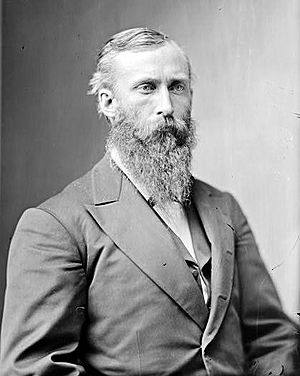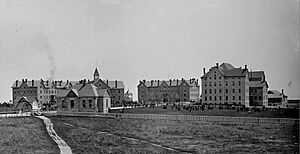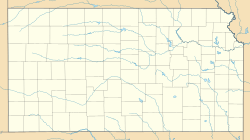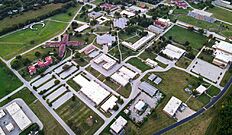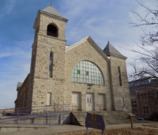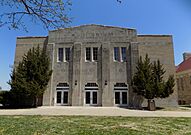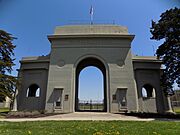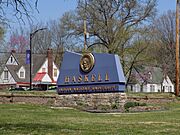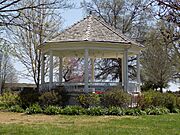Haskell Indian Nations University facts for kids
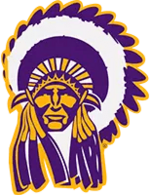 |
|
|
Former names
|
United States Indian Industrial Training School (1884–1887) Haskell Institute (1887–1970) Haskell Indian Junior College (1970–1993) |
|---|---|
| Type | Public tribal land-grant university |
| Established | 1884 |
|
Academic affiliations
|
AIHEC, Space-grant |
| Students | 878 (all undergraduate) (fall 2024) |
| Location |
,
U.S.
|
| Colors | Purple, gold and white |
| Nickname | Fighting Indians |
|
Sporting affiliations
|
NAIA – Continental |
 |
|
Haskell Indian Nations University (often called Haskell or HINU) is a special public university in Lawrence, Kansas, USA. It's a "tribal" university, meaning it's mainly for Native American students.
Haskell started in 1884 as a boarding school for Native American children. Over time, it grew into a university. It is run by the U.S. Bureau of Indian Affairs. Today, Haskell offers both two-year (associate) and four-year (bachelor's) degrees. It is the oldest federal school for American Indians that has been open continuously.
Students from about 140 different Native American tribes and Alaska Native communities attend Haskell. The U.S. government helps fund the school. Students do not pay tuition, but they do pay some yearly fees.
Many buildings on Haskell's campus are important. Twelve of them are even called U.S. National Historic Landmarks. The university has a Cultural Center and Museum. It also has the American Indian Athletic Hall of Fame. The Indian Leader is the oldest Native American student newspaper in the country. Haskell also has many student clubs.
In 1992, teachers and students built the Haskell Medicine Wheel Earthwork. The nearby Haskell-Baker Wetlands are very important for birds that migrate. Haskell also hosts fun cultural and academic events. These events bring visitors from all over, including the Haskell Indian Art Market and the Haskell Commencement and Pow-Wow.
Contents
Haskell's Story: A Look Back
The story of Haskell Indian Nations University shows how U.S. policies toward Native Americans have changed. It also shows how Native American communities have worked for their own future.
Early Days: A Boarding School (1884-1960s)
Haskell was founded in 1884. At that time, the government wanted Native Americans to adopt the majority culture. The government set up boarding schools away from reservations. Children from different tribes were sent to these schools. They were expected to leave behind their tribal traditions. The Carlisle Indian Industrial School was a model for these schools.
When Haskell opened, it was called the "United States Indian Industrial Training School." It started with 22 elementary students. Boys learned trades like tailoring and farming. Girls learned cooking and sewing. Students often worked on the school's farm to help produce food.
Life at the school in the 1880s and 1890s was tough. Students wore uniforms and had their hair cut short. This was meant to make them conform and lose their tribal identity. They marched to classes and exercised. Students were often punished if they didn't follow the rules.
In 1887, the school was renamed "Haskell Institute." This was to honor Dudley Haskell, a U.S. representative from Kansas. He helped get the school built in Lawrence.
In the early 1900s, Haskell grew. It added classes for older students. By 1927, it was an accredited high school in Kansas. By 1935, it became a vocational-technical school.
From the 1900s to the 1930s, Haskell was famous for its football teams. They were known as the "Powerhouse of the West." They played against big colleges like Harvard and Yale.
Becoming a College and University (1960s-Today)
In the 1960s, Native Americans worked to strengthen their cultures. They wanted more control over their children's education. In 1965, Haskell had its last high school graduating class.
Two years later, in 1967, the school became "Haskell Indian Junior College." It started offering two-year degrees. In the late 1980s, plans began to make it a four-year university.
In 1993, the school was renamed Haskell Indian Nations University. It began offering its first four-year bachelor's degree in elementary teacher education. Soon after, it added degrees in American Indian Studies, Business Administration, and Environmental Sciences.
In 1994, Congress made Haskell and other tribal colleges "land-grant colleges." This gave them more support for their programs.
By the early 2000s, Haskell had become a university focused on Native American goals. As of 2023, it had about 878 students. Many Haskell graduates now work to help Native American and Alaska Native communities.
In early 2025, Haskell had to reduce its staff due to budget cuts.
Exploring the Campus
|
Haskell Institute
|
|
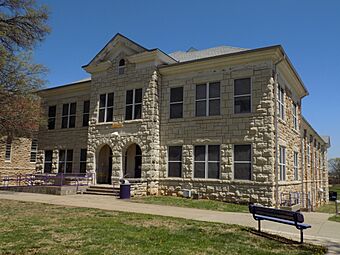
Haskell's Tecumseh Hall (2018)
|
|
| Location | Lawrence, Kansas |
|---|---|
| NRHP reference No. | 66000342 |
| Significant dates | |
| Added to NRHP | October 15, 1966 |
| Designated NHLD | July 4, 1961 |
Haskell's campus has 12 buildings that are U.S. National Historic Landmarks. The campus also has many sculptures, murals, and paintings. One famous sculpture is Comrade in Mourning by Allan Houser.
The Haskell-Baker Wetlands are about 640 acres (259 ha) on the south side of campus. These wetlands are home to many kinds of birds, fish, reptiles, and plants. They are a vital spot for migratory birds traveling between Canada and Mexico/South America. An endangered species, the Northern Crawfish Frog, lives here.
Campus Buildings and Halls
Blalock Hall
Built in 1978, Blalock Hall is a dorm for first-year male students. It was named after Margaret Blalock, a Haskell graduate and long-time employee.
Hiawatha Hall
Hiawatha Hall was built in 1898. It was named after the historic Onondaga leader, Hiawatha. The United Methodist Church built it as a chapel. It is the oldest building still standing on campus. The building has been closed for many years because it needs repairs.
Osceola and Keokuk Halls
These two halls, built in 1884, are known as O-K Hall. They used to be separate dorms for men and women. Osceola was a famous Seminole warrior. Keokuk was a respected Sac and Fox leader. Today, O-K Hall is a dorm for both women and men.
Pocahontas Hall
Pocahontas Hall was built in 1931. It was named after Pocahontas, the daughter of Chief Powhatan. It is a dorm for first-year female students.
Pontiac Hall
Built in 1934, Pontiac Hall was named after an Ottawa chief. It is located south of the main campus area.
Powhatan Hall
Powhatan Hall was built in 1932. It was named after the chief of the Powhatan Confederacy. It used to have classrooms but is now a dorm for student assistants.
Roe Cloud Hall
Completed in 1997, Roe Cloud Hall was named after Henry Roe Cloud. He was the first American Indian superintendent of Haskell Institute (1933-1935). He spoke up for American Indian issues and education. It is a dorm for both men and women.
Sequoyah Hall
Sequoyah Hall was built in 1961. It was named for Sequoyah, the Cherokee who created a writing system for the Cherokee language. It is on the eastern side of the main campus area.
Tecumseh Hall
Built in 1915, Tecumseh Hall was a gymnasium. It was named after the Shawnee chief. Today, it holds the Campus Shoppe, student offices, and the campus newspaper, Indian Leader.
Winona Hall
Winona Hall was first built in 1897 and rebuilt in 1962. The name Winona means "first-born daughter" in Lakota tradition. Winona Hall is now a co-ed honors dorm for both women and men.
- Haskell campus buildings
Museums and Libraries
The Haskell Cultural Center and Museum shows exhibits about the school's history since 1884. It also has collections on Native American history.
Tommaney Library offers many resources for school research. These include books, online materials, and digital files.
Haskell Medicine Wheel Earthwork
The Haskell Medicine Wheel Earthwork is south of the campus. Haskell professors, students, artist Stan Herd, and tribal elders designed it. It was dedicated in 1992.
The medicine wheel earthwork shows the rich history of Native cultures. The circle stands for the never-ending and sacred nature of Native spirituality. The spokes point to the four directions. The circle also marks the Summer and Winter solstices. It represents new beginnings, balance, and healing. The bear claw shows the strength needed for Native people to survive. The thunderbird points to the spiritual traditions of tribal people.
A smaller version of the medicine wheel is carved into the tile at the Haskell Cultural Center and Museum. This helps balance the campus.
What Haskell Teaches
Haskell is one of 37 members of the American Indian Higher Education Consortium. This group supports tribal colleges and universities.
Haskell offers four bachelor's degree programs and four associate degrees.
Two-Year (Associate) Degree Programs
Haskell offers Associate of Arts (AA) degrees in:
- Communication Studies
- Liberal Arts
- Media Communication
- Para Professional Education
- Social Work
It also offers Associate of Science (AS) degrees in:
- Community Health
- Natural Sciences
- Recreation Fitness Management
Four-Year (Bachelor's) Degree Programs
Haskell offers these four bachelor's programs:
Indigenous and American Indian Studies (BA)
This program teaches about Native American and Alaska Native communities. Students learn skills to help these communities grow. It prepares students for advanced studies or jobs.
Business Administration (BS)
This program offers a Bachelor of Science in Business Administration. Students can focus on general management or tribal management. The tribal management track looks at issues that affect tribal governments and businesses.
Elementary Teacher Education (BS)
Students in this program earn a Bachelor of Science Degree in Elementary Education. They learn to teach kindergarten through sixth grade.
Environmental Sciences (BS)
This program gives students a broad background in environmental and biological fields. It prepares them for graduate school or careers in these areas. Courses include Biology, Ecology, Chemistry, and Geography. It connects to Native concerns about keeping the Earth healthy.
Student Life
| Race and ethnicity | Total | ||
|---|---|---|---|
| American Indian/Alaska Native | 100% |
|
|
| Economic diversity | |||
| Low-income | 60% |
|
|
| Affluent | 40% |
|
|
More than 20 student groups and clubs are on campus. They give students chances to get involved in campus life and the community.
Sports at Haskell
Haskell's sports teams are called the Fighting Indians. Their colors are purple, gold, and white. The university is part of the National Association of Intercollegiate Athletics (NAIA).
Haskell has 11 varsity sports:
- Men's sports: basketball, cross country, golf, and track & field (indoor and outdoor).
- Women's sports: basketball, cross country, softball, track & field (indoor and outdoor), and volleyball.
Club sports include baseball and boxing.
Football History
Haskell had one of the best college football teams from 1900 to 1930. However, the football program was stopped in 2015 due to a lack of funding.
Famous People from Haskell
- Evelyne Bradley - American Navajo judge
- Emmett Bowles - professional baseball player
- Venida Chenault - government official and academic leader
- Henry Roe Cloud - Tribal education advocate
- Sharice Davids - Member of U.S. Congress
- Larry Johnson - professional football player
- Buck Jones - professional football player
- Nick Lassa - professional football player
- Gilbert L. Laws - Nebraska Secretary of State and US Congressman
- Edward E. McClish - American military officer
- Mayes McLain - professional football player
- Emmett McLemore - professional football player
- Billy Mills - Olympic gold medalist in running
- Joe Pappio - professional football player
- Stan Powell - professional football player
- Steve Reevis - actor
- Pauline Small - first woman elected to a Crow Nation tribal office
- Barbara Starr Scott - Cherokee Nation tribal councilor
- Jim Thorpe - Double Gold Medalist at the 1912 Olympic Games, famous athlete
- Louis Weller - professional football player
See also


